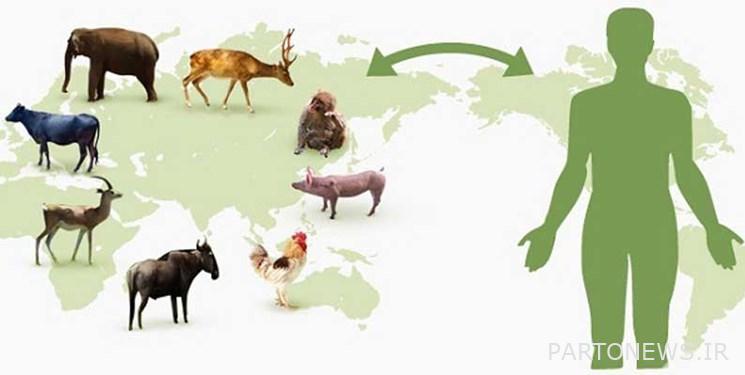Beware of these 200 types of dangerous diseases

According to Fars News Agency’s health correspondent, zoonotic diseases are diseases that can be transmitted between animals and humans, basically from the group of bacteria, viruses, fungi and parasites. The most important common diseases between humans and animals that can be seen in our country are Malt fever, Salk, rabies, anthrax, hydatid cyst and Crimean-Congo hemorrhagic fever. On the other hand, for various reasons, the risk of entering other diseases such as mad cow disease, Rift Valley fever, bird flu, etc. should not be ignored.
The risk of transmissible diseases between animals and humans is higher in Iran due to the presence of infected countries in our neighborhood, some of which lack the necessary political stability to have a proper health system. Apart from the general health situation in neighboring countries, animal smuggling from neighboring countries’ borders has also caused an increase in anthrax disease in some border areas of the country. In order to deal with diseases that can be transmitted between animals and humans, animal vaccination and animal testing are done, and in cases where it is necessary, infected animals are killed or euthanized, and compensation is paid to livestock farmers for killing them.
Transmissible diseases between humans and animals are the intersection of 2 medical and veterinary professions, which are of great importance in terms of maintaining the health and hygiene of human and animal societies. The name of this category of diseases represents the common and serious responsibility that is shared by doctors and veterinarians in the field of prevention, diagnosis and treatment of such diseases.
Mehrdad Haghighi, associate professor and specialist in infectious diseases at Shahid Beheshti University of Medical Sciences On the occasion of World Day of Zoonotic Diseases, he said: July 6th, corresponding to July 15th, the anniversary of the first rabies vaccine administration in 1885 by Louis Pasteur, has been named as World Zoonosis Day.
There are 200 types of zoonotic diseases in the world
Referring to the identification of 200 types of zoonotic diseases in the world, this associate professor of the university’s infectious disease department said: Due to the climatic conditions, ecosystem and the great diversity of animal species, common diseases of humans and animals are widespread and prevalent in different parts of the world.
Regarding the damages caused by these diseases on the health and public health of the society and the losses and economic burden on the health system of the countries, Haghigi emphasized that the control of these diseases is very important.
According to him, due to the diversity of urban and rural contexts, different climates and environmental conditions, these diseases are very prevalent and important in Iran.
This associate professor of the university considered zoonotic diseases as infections that can be transmitted from animals to humans and are transmitted to humans by bacteria, viruses, fungi and even parasites and cause disease.
This member of the academic staff of the university mentioned diseases such as Malta fever, Crimean and Congo fever, anthrax, salicy, toxoplasmosis, leptospirosis, rabies and hydatid among the common diseases of humans and animals, which cause a number of people to fight in our country every year. Unfortunately, in some cases they are also associated with death.
Referring to the increase in the probability of cases of Crimean-Congo fever during Eid al-Adha and unsanitary animal slaughter, he emphasized that there is a possibility of this disease occurring if the necessary standards are not met during animal slaughter and the consumption of unhealthy meat.
Referring to the history of Crimean-Congo fever in Iran, Haghighi said: This disease was officially confirmed and identified in our country for the first time in 1378.
Referring to the transmission of Crimean and Congo fever from infected animals to humans and its transmission from human to human, he said: The symptoms of this disease appear one to three days after being bitten by an infected tick or five to six days after a person comes into contact with an infected animal. will be
According to him, the disease enters the bleeding stage after a few days and eventually it may lead to the death of the patient.
According to him, some zoonotic diseases can be prevented by using vaccination and other methods.
Haghighi listed HIV as one of the infections that initially started as zoonotic diseases and then changed to a human-specific infection.
According to him, some of these infections, such as the Ebola virus and salmonellosis, have the ability to cause recurrent epidemics, and others, such as the corona virus, have the ability to become a pandemic.
60% of infectious diseases are of animal origin
This infectious diseases expert pointed out that about 60% of infectious diseases can have an animal origin and noted that a significant percentage of newly emerging infectious diseases have an animal origin.
According to the high prevalence of this category of diseases in the society, Haghigi considered it necessary to cooperate with the relevant organizations, including the Ministry of Health, Veterinary Organization, Environmental Protection Organization and the media in the field of information, education and control of these diseases.
Ways of transmission of zoonotic diseases
Referring to the ways of transmission of zoonotic diseases, the university faculty member said: Considering that various pathogens, vectors and animals are responsible for the transmission and creation of this group of diseases, the methods of disease transmission are also completely different and diverse.
Referring to the symptomless nature of the disease-carrying animal in many cases, Haghigi reminded: if a person comes in contact with this infected animal and does not follow the basic principles of health care, he will get these infections.

According to him, the owners of some jobs are more susceptible to zoonotic diseases, which include cattle breeders, farmers, people working in rice fields, sellers and owners of pets, slaughterhouse workers, foresters and zoo workers.
The university faculty member warned the compatriots: any direct or indirect contact without observing health standards with animals (both wild, domestic and birds) as well as being bitten by some insects can cause such diseases.
He mentioned contact with an infected animal or its secretions, biting or scratching by an infected animal, consumption of contaminated meat, dairy and animal products, drinking or contact with contaminated water, consumption of contaminated vegetables and bites by insects such as ticks as the ways of transmission of zoonotic diseases.
Disease symptoms
This specialist in infectious diseases considered the range of clinical symptoms of common diseases between humans and animals to be very variable, which can be seen from mild to very severe and sometimes even with death.
Haghighi listed children under five years old, people over 65 years old, patients with immune system defects and pregnant women as the people who are likely to get more severe forms of the disease.
This expert of infectious diseases of the university added: For example, toxoplasmosis, which is transmitted by cats, is usually symptomless or associated with mild symptoms in people with a normal immune system, but in people with immune deficiency, it can cause dangerous problems and complications.
According to him, in some zoonosis infections, such as rabies and Crimean and Congo fever, due to the nature of the disease, even in people with a normal immune system, the severity and complications of the disease are such that it can lead to serious problems and even death.
ways of prevention
Regarding the methods of preventing these diseases, this associate professor of the university said: For some of these infections, such as rabies, there is a useful and effective vaccine that people at risk can receive at the appropriate time and before encountering animals.
Pointing to the effective role of observing hygiene principles in preventing these infections, he added: washing hands, especially after contact with animals, and using appropriate clothing such as gloves when contacting animals or livestock products can be very effective in preventing infection. .
Haghighi mentioned that the preparation of meat and animal and dairy products from reliable sources and approved by the responsible organizations, proper cooking of food, accurate and proper washing of fruits and vegetables are among the effective solutions in preventing disease.
According to this associate professor of the University’s Infectious Diseases Department, preventing insect bites with a suitable cover and using insecticides and repellants can also be very helpful in this regard.
He mentioned the vaccination of animals and their periodic visits by veterinarians as important and significant points for preventing this type of infection.
Haghigi pointed out: Many common diseases of humans and animals are treatable and if the patient is referred on time and correctly diagnosed and proper treatment is started, the possibility of recovery and elimination of the disease is completely possible.
end of message/

